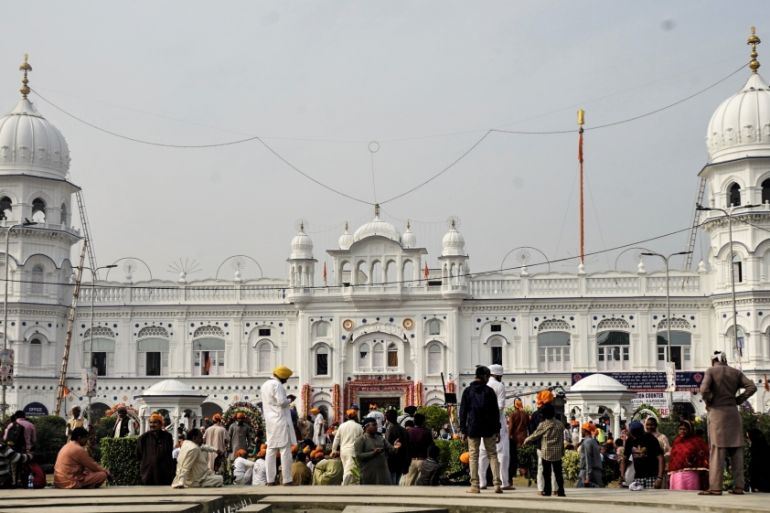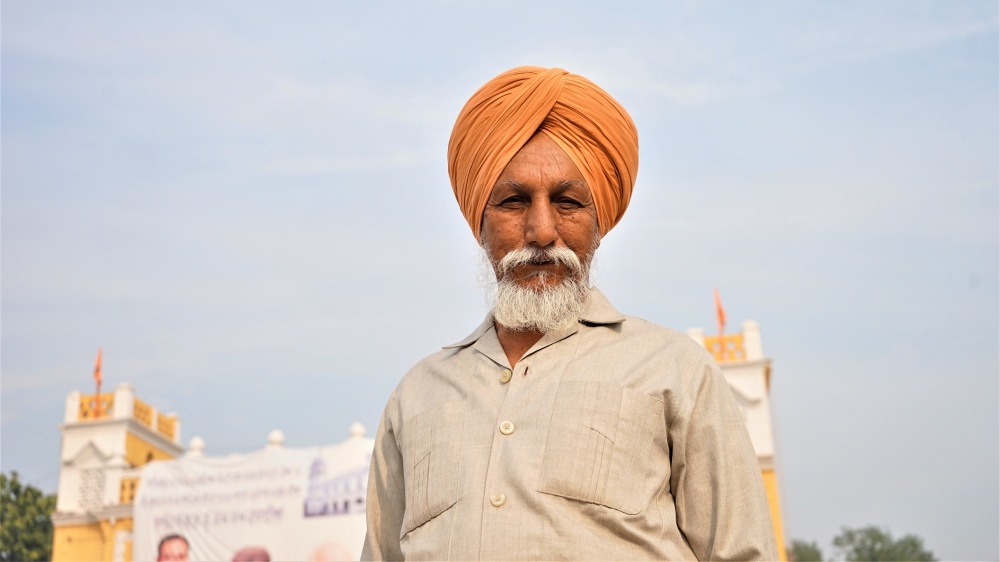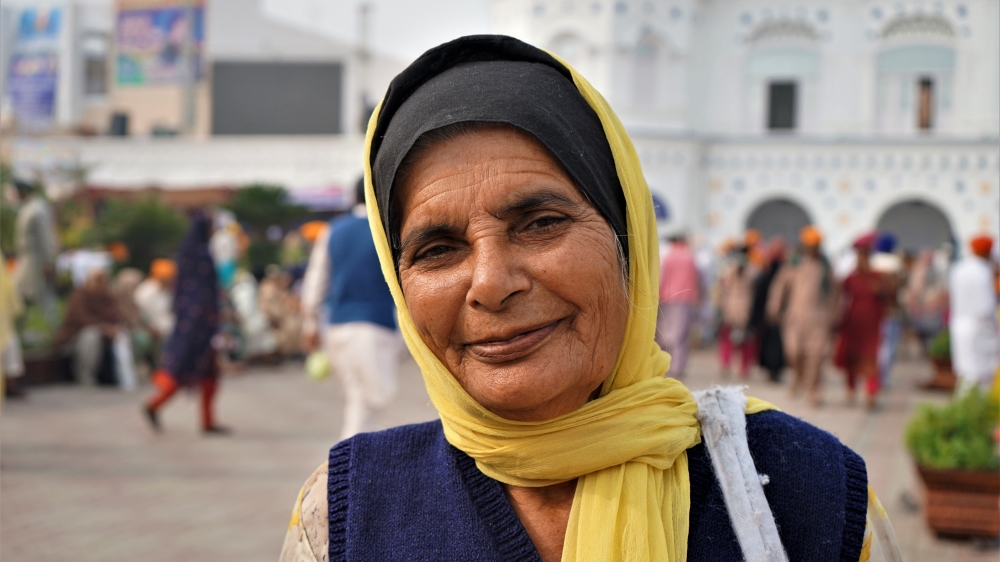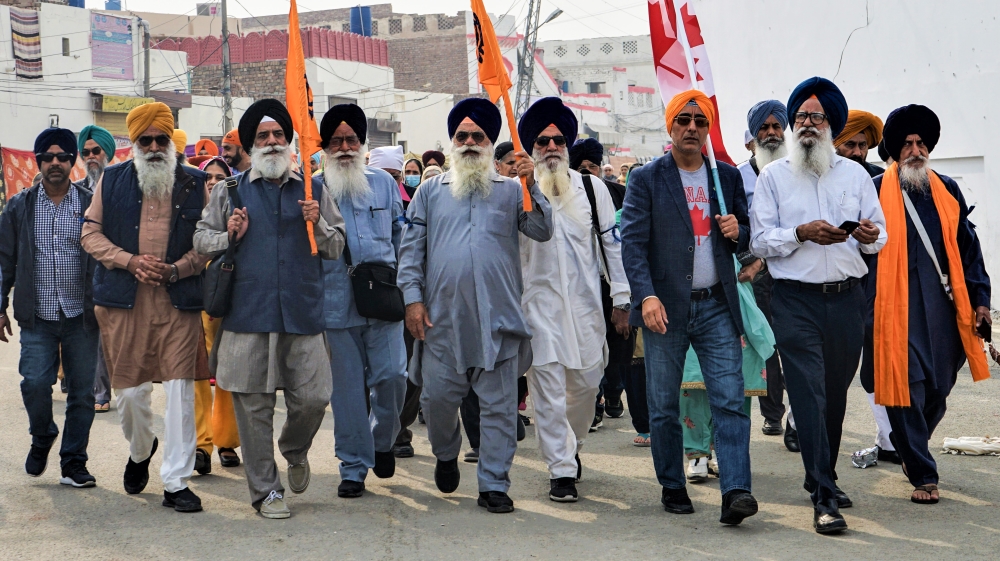Sikhs mark Guru Nanak’s 550th birth anniversary in Pakistan
Despite India-Pakistan tensions, hometown of Sikhism’s founder draws thousands of Sikhs from India and around the world.

Nankana Sahib, Pakistan – When Sikh devotee Gurmit Singh crossed the Indian border to visit Sikhism’s holiest sites in Pakistan this month, he set out on the journey alone. At 67, Gurmit Singh had hoped his family in the Indian city of Chandigarh would join him, but their applications were rejected.
Nonetheless, Gurmit Singh had grown up dreaming of visiting Sikhism’s most cherished sites and was determined to fulfil his lifelong dream of seeing Kartarpur, the town where Sikhism’s founder, Guru Nanak, was believed to have spent his final years.
Keep reading
list of 3 itemsGuru Nanak and the promise of an inclusive Pakistan
Pakistan to launch university in honour of first Sikh Guru
“I didn’t know what to expect. My goal in life was to see these holy sites,” he told Al Jazeera.

On Tuesday morning, Gurmit Singh, and thousands of Sikhs from around the world, poured into the eastern city of Nankana Sahib to commemorate the 550th birth anniversary of Guru Nanak at the ornate, palatial structure of the Gurdwara Janam Asthan.
Guru Nanak was born in this city in 1469. Today, the predominantly Muslim town attracts Sikh pilgrims from around the globe.
Pakistan is officially home to 20,000 Sikhs, who number about 20 million worldwide, with the vast majority in India.
Opening of Kartarpur corridor
In 1947, when India and Pakistan gained independence from the British, the state of Punjab was cleaved in half, permanently dividing Sikhism’s holiest sites between the South Asian rivals. Under a 1974 bilateral agreement, India and Pakistan opened the possibility of undertaking cross-border pilgrimages to visit each other’s religious shrines.
This year saw Guru Nanak’s birth celebrations increase in prominence due to the opening of the Kartarpur corridor, a nearly five-kilometre (3-mile) long land-link that allows Sikhs from India visa-free access to one of Sikhism’s holiest shrines in Pakistan.
Prior to the construction of the corridor, thousands of Sikhs would stand on the fence along the India-Pakistan border to gaze at the gurdwara (Sikh temple) through a telescope, tears clouding their eyes. Now, up to 5,000 pilgrims a day have been permitted by the Pakistani government.
“The Kartarpur corridor will promote peace and harmony between the two countries at a time when everything – including trade – is at a standstill,” said Aamer Ahmed, chairman of the Evacuee Trust Property Board (ETPB), the main government body tasked with maintaining Sikh and Hindu religious sites across Pakistan.
“Pakistan is the land of the Sikhs,” echoed Imran Gondal, the ETPB’s Deputy Secretary of Shrines. “We encourage them to visit Pakistan.”
In previous years, however, Sikh pilgrimages had been interrupted by the bitter enmity that periodically mars relations between the nuclear-armed South Asian neighbours.
Recently, the ongoing Kashmir dispute locked the rivals into a prolonged tension, with Pakistan suspending trade, downgrading diplomatic ties, and raising the issue at every international forum.
Ramesh Singh Arora, a leading Pakistani Sikh politician who introduced the country’s first Sikh marriage legislation, said that Pakistan had been committed to opening the Kartarpur corridor on time.
“If you look at the last 10 months, there was a lot of tension between these two countries,” said Arora. “But the Pakistani government didn’t stop the construction work at Kartarpur. It wanted to send the message that it would give the Sikhs free and open access to Kartarpur.”

Other Indian Sikh pilgrims, such as 66-year-old Paulkaur Singh, saw their trip to Pakistan as a way to heal the wounds of the Partition, the violent event that saw mass displacement and population exchanges as the South Asian borders were redrawn in 1947.
Paulkaur Singh’s husband had fled Bahawalpur, a city in Pakistan’s Punjab province, to go to Haryana on the Indian side. He never reconnected with the home that he left behind in his dash towards safety and a new country.
Someday, Paulkaur Singh hopes to have a glimpse of her late husband’s city, but she said it currently feels impossible on a government-approved travel itinerary restricted to Sikh heritage sites.
For now, Paulkaur Singh contends herself with being able to see Kartarpur in person, calling it her “asli ghar” (or true home). Unable to reach their revered holy site for decades, many Indian Sikhs had simply watched from afar. “Now we can do darshan openly,” Paulkaur Singh said.
‘No difference between us’
At the gurdwara’s “sarovar” (or sacred pool) where Sikhs take a ceremonial bath, the Indian Sikhs were also joined by Pakistan’s own minorities.
Muzawer Mal, a Nanakpanthi Hindu from Pakistan’s southeast Sindh province, stood beaming at the site of Guru Nanak’s birthplace. “I came here five times to roam with my 12 children. We have such a strong connection to Guru Nanak,” he said.
“There is no difference between us, we are all Guru Nanak’s followers,” echoed Esardas Punjabi, a 55-year-old Nanakpanthi Hindu who had taken a 12-hour bus from Shikarpur, Pakistan to celebrate with Indian Sikhs. “I am extremely happy to be here.”
Nanakpanthis are followers of Guru Nanak, though some of them may also identify themselves as Hindus. A significant number of them live in Pakistan’s Sindh province.
Among Nankana Sahib’s celebrants was a group of Sikhs from North America and Europe, who had undertaken a special “Journey to Kartarpur” road trip to the holy site, crisscrossing Turkey, Iran, the United Kingdom, Italy, and the rest of Europe to spread a message of peace.
The group visited gurdwaras in Europe to collect donations and eventually reached Pakistan’s Punjab province, where security officials offered steaming cups of tea and bantered in Punjabi, recalled 61-year-old Ranjit Singh Sandhu.
Sandhu, who runs a truck company in Canada, said the highlight of his trip was the number of tea invites he received. “Every person treats us respectfully. They offered us cups of chai and wanted to show us around, but we didn’t have time,” he chuckles.
Sandhu said he believed that ordinary people want peace on both sides, and that little divides the citizens in both countries.
“There is no difference between them. The police are the same on both sides of the border, the food and drinks are the same. The only difference is the name. We are Sikhs, they are Muslims, but we are the same people,” he said. “If Guru Nanak blesses us, I would love to come every year.”
